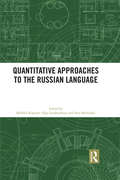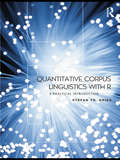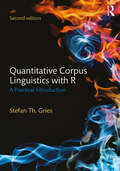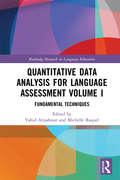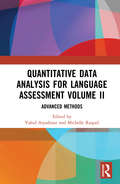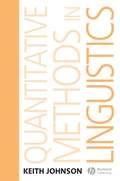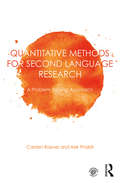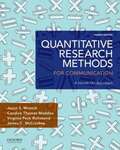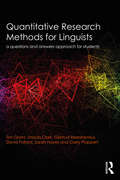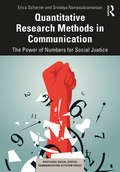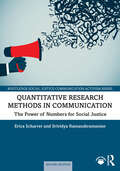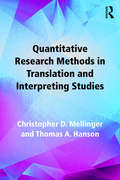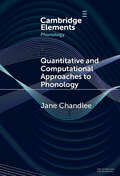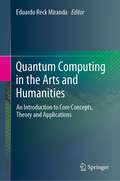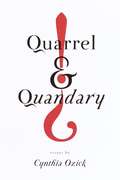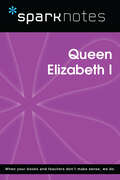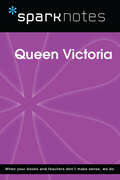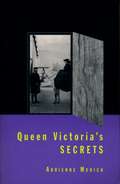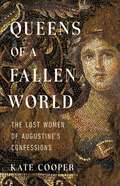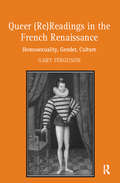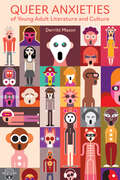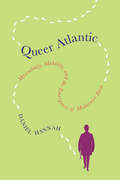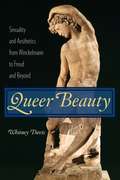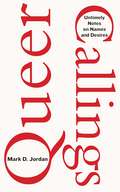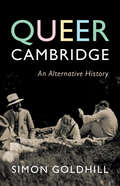- Table View
- List View
Quantitative Approaches to the Russian Language
by Arto Mustajoki Mikhail Kopotev Olga LyashevskayaThis edited collection presents a range of methods that can be used to analyse linguistic data quantitatively. A series of case studies of Russian data spanning different aspects of modern linguistics serve as the basis for a discussion of methodological and theoretical issues in linguistic data analysis. The book presents current trends in quantitative linguistics, evaluates methods and presents the advantages and disadvantages of each. The chapters contain introductions to the methods and relevant references for further reading. This will be of interest to graduate students and researchers in the area of quantitative and Slavic linguistics.
Quantitative Corpus Linguistics with R: A Practical Introduction
by Stefan Th. GriesThe first textbook of its kind, Quantitative Corpus Linguistics with R demonstrates how to use the open source programming language R for corpus linguistic analyses. Computational and corpus linguists doing corpus work will find that R provides an enormous range of functions that currently require several programs to achieve – searching and processing corpora, arranging and outputting the results of corpus searches, statistical evaluation, and graphing.
Quantitative Corpus Linguistics with R: A Practical Introduction
by Stefan Th. GriesAs in its first edition, the new edition of Quantitative Corpus Linguistics with R demonstrates how to process corpus-linguistic data with the open-source programming language and environment R. Geared in general towards linguists working with observational data, and particularly corpus linguists, it introduces R programming with emphasis on: data processing and manipulation in general; text processing with and without regular expressions of large bodies of textual and/or literary data, and; basic aspects of statistical analysis and visualization. This book is extremely hands-on and leads the reader through dozens of small applications as well as larger case studies. Along with an array of exercise boxes and separate answer keys, the text features a didactic sequential approach in case studies by way of subsections that zoom in to every programming problem. The companion website to the book contains all relevant R code (amounting to approximately 7,000 lines of heavily commented code), most of the data sets as well as pointers to others, and a dedicated Google newsgroup. This new edition is ideal for both researchers in corpus linguistics and instructors who want to promote hands-on approaches to data in corpus linguistics courses.
Quantitative Data Analysis for Language Assessment Volume I: Fundamental Techniques (Routledge Research in Language Education)
by Vahid Aryadoust Michelle RaquelQuantitative Data Analysis for Language Assessment Volume I: Fundamental Techniques is a resource book that presents the most fundamental techniques of quantitative data analysis in the field of language assessment. Each chapter provides an accessible explanation of the selected technique, a review of language assessment studies that have used the technique, and finally, an example of an authentic study that uses the technique. Readers also get a taste of how to apply each technique through the help of supplementary online resources that include sample data sets and guided instructions. Language assessment students, test designers, and researchers should find this a unique reference as it consolidates theory and application of quantitative data analysis in language assessment.
Quantitative Data Analysis for Language Assessment Volume II: Advanced Methods
by Vahid Aryadoust Michelle RaquelQuantitative Data Analysis for Language Assessment Volume II: Advanced Methods emonstrates advanced quantitative techniques for language assessment. The volume takes an interdisciplinary approach and taps into expertise from language assessment, data mining, and psychometrics. The techniques covered include Structural Equation Modeling, Data Mining, Multidimensional Psychometrics and Multilevel Data Analysis.Volume II is distinct among available books in language assessment, as it engages the readers in both theory and application of the methods and introduces relevant techniques for theory construction and validation. This book is highly recommended to graduate students and researchers who are searching for innovative and rigorous approaches and methods to achieve excellence in their dissertations and research. It is also a valuable source for academics who teach quantitative approaches in language assessment and data analysis courses.
Quantitative Methods In Linguistics
by Keith JohnsonQuantitative Methods in Linguistics offers a practical introduction to statistics and quantitative analysis with data sets drawn from the field and coverage of phonetics, psycholinguistics, sociolinguistics, historical linguistics, and syntax, as well as probability distribution and quantitative methods. Provides balanced treatment of the practical aspects of handling quantitative linguistic data Includes sample datasets contributed by researchers working in a variety of sub-disciplines of linguistics Uses R, the statistical software package most commonly used by linguists, to discover patterns in quantitative data and to test linguistic hypotheses Includes student-friendly end-of-chapter assignments and is accompanied by online resources at available in the 'Downloads' section, below
Quantitative Methods for Second Language Research: A Problem-Solving Approach
by Aek Phakiti Carsten RoeverQuantitative Methods for Second Language Research introduces approaches to and techniques for quantitative data analysis in second language research, with a primary focus on second language learning and assessment research. It takes a conceptual, problem-solving approach by emphasizing the understanding of statistical theory and its application to research problems while paying less attention to the mathematical side of statistical analysis. The text discusses a range of common statistical analysis techniques, presented and illustrated through applications of the IBM Statistical Package for Social Sciences (SPSS) program. These include tools for descriptive analysis (e.g., means and percentages) as well as inferential analysis (e.g., correlational analysis, t-tests, and analysis of variance [ANOVA]). The text provides conceptual explanations of quantitative methods through the use of examples, cases, and published studies in the field. In addition, a companion website to the book hosts slides, review exercises, and answer keys for each chapter as well as SPSS files. Practical and lucid, this book is the ideal resource for data analysis for graduate students and researchers in applied linguistics.
Quantitative Research Methods For Communication: A Hands-on Approach
by Jason S. Wrench Virginia Peck Richmond Candice Thomas-MaddoxQuantitative Research Methods for Communication: A Hands-On Approach is a relevant and accessible guide to quantitative research. In clear, straightforward language, the authors encourage students to take an active, hands-on role in the learning process, giving them the tools they need to locate, conduct, collect and present their research. The authors use real communication studies and data sets to make communication research come alive for students. Students are not only introduced to new skills but also given the opportunity to immediately apply these skills in research scenarios. The text integrates helpful features throughout, including chapter objectives, case studies, data sheets, and key terms.
Quantitative Research Methods for Linguists: a questions and answers approach for students
by Sarah Hayes Dave Pollard Tim Grant Urszula Clark Garry Plappert Gertrud ReershemiusQuantitative Research Methods for Linguistics provides an accessible introduction to research methods for undergraduates undertaking research for the first time. Employing a task-based approach, the authors demonstrate key methods through a series of worked examples, allowing students to take a learn-by-doing approach and making quantitative methods less daunting for the novice researcher. Key features include: Chapters framed around real research questions, walking the student step-by-step through the various methods; Guidance on how to design your own research project; Basic questions and answers that every new researcher needs to know; A comprehensive glossary that makes the most technical of terms clear to readers; Coverage of different statistical packages including R and SPSS. Quantitative Research Methods for Linguistics is essential reading for all students undertaking degrees in linguistics and English language studies.
Quantitative Research Methods in Communication: The Power of Numbers for Social Justice (Routledge Social Justice Communication Activism Series)
by Erica Scharrer Srividya RamasubramanianThis textbook is an advanced introduction to quantitative methods for students in communication and allied social science disciplines that focuses on why and how to conduct research that contributes to social justice. Today’s researchers are inspired by the potential for scholarship to make a difference for society, to push toward more just and equitable ends, and to engage in dialogue with members of the public so that they can make decisions about how to navigate the social, cultural, and political world equipped with accurate, fair, and up-to-date knowledge. This book illustrates the mechanics and the meaning behind quantitative research methods by illustrating each step in the research design process with research addressing questions of social justice. It provides practical guidance for researchers who wish to engage in the transformation of structures, practices, and understandings in society through community and civic engagement and policy formation. It contains step-by-step guidance in quantitative methods—from conceptualization through all the stages of execution of a study, including providing a detailed guide for statistical analysis—and demonstrates how researchers can engage with social justice issues in systematic, rigorous, ethical, and meaningful ways. This text serves as a core or supplementary textbook for graduate and advanced undergraduate courses in research methods for communication and social sciences and fills a gap for a methods text that is responsive to the desire of scholars to conduct socially impactful research.
Quantitative Research Methods in Communication: The Power of Numbers for Social Justice (Routledge Social Justice Communication Activism Series)
by Erica Scharrer Srividya RamasubramanianThis fully updated second edition offers an advanced introduction to quantitative methods that focuses on why and how to conduct research that contributes to social justice.Providing both inspiration and step-by-step guidance on how to conceive, design, and carry out a quantitative study, the book shows how research can be used to work toward a more just and equitable world. The authors provide a detailed guide to quantitative methods and statistical analysis, showing how researchers can engage with social justice issues in systematic, rigorous, ethical, and meaningful ways. This new edition includes a new chapter on writing literature reviews and better aligns with the stages of quantitative research as well as the changing technologies that are available for researchers to both study and use in their work. It includes updated real-world case studies, interviews with scholar-activists, and definitions of key concepts as well as a deeper focus on ethics, social media, computational social sciences, data analytics, and data visualization techniques.Attuned to questions of access, equity, justice, diversity, and inclusion, this textbook is ideal for graduate and advanced undergraduate courses in research methods for communication and the social sciences. It will also be of interest to researchers who wish to engage with the transformation of structures, practices, and understandings in society through community and civic engagement and policy formation.Online resources for instructors include a test bank, PowerPoint slides, sample dataset, and YouTube tutorials. They are available online at www.routledge.com/9781032599878.
Quantitative Research Methods in Translation and Interpreting Studies
by Christopher Mellinger Thomas A. HansonQuantitative Research Methods in Translation and Interpreting Studies encompasses all stages of the research process that include quantitative research methods, from conceptualization to reporting. In five parts, the authors cover: • sampling techniques, measurement, and survey design; • how to describe data; • how to analyze differences; • how to analyze relationships; • how to interpret results. Each part includes references to additional resources and extensive examples from published empirical work. A quick reference table for specific tests is also included in the appendix. This user-friendly guide is the essential primer on quantitative methods for all students and researchers in translation and interpreting studies. Accompanying materials are available online, including step-by-step walkthroughs of how analysis was conducted, and extra sample data sets for instruction and self study: https://www.routledge.com/9781138124967. Further resources for Translation and Interpreting Studies are available on the Routledge Translation Studies Portal: http://cw.routledge.com/textbooks/translationstudies.
Quantitative and Computational Approaches to Phonology (Elements in Phonology)
by Jane ChandleeThis Element surveys the various lines of work that have applied algorithmic, formal, mathematical, statistical, and/or probabilistic methods to the study of phonology and the computational problems it solves. Topics covered include: how quantitative and/or computational methods have been used in research on both rule- and constraint-based theories of the grammar, including questions about how grammars are learned from data, how to best account for gradience as observed in acceptability judgments and the relative frequencies of different structures in the lexicon, what formal language theory, model theory, and information theory can and have contributed to the study of phonology, and what new directions in connectionist modeling are being explored. The overarching goal is to highlight how the work grounded in these various methods and theoretical orientations is distinct but also interconnected, and how central quantitative and computational approaches have become to the research in and teaching of phonology.
Quantum Computing in the Arts and Humanities: An Introduction to Core Concepts, Theory and Applications
by Eduardo Reck MirandaComputers are essential for the functioning of our society. Despite the incredible power of existing computers, computing technology is progressing beyond today’s conventional models. Quantum Computing (QC) is surfacing as a promising disruptive technology. QC is built on the principles of quantum mechanics. QC can run algorithms that are not trivial to run on digital computers. QC systems are being developed for the discovery of new materials and drugs and improved methods for encoding information for secure communication over the Internet. Unprecedented new uses for this technology are bound to emerge from ongoing research.The development of conventional digital computing technology for the arts and humanities has been progressing in tandem with the evolution of computers since the 1950s. Today, computers are absolutely essential for the arts and humanities. Therefore, future developments in QC are most likely to impact on the way in which artists will create and perform, and how research in the humanities will be conducted.This book presents a comprehensive collection of chapters by pioneers of emerging interdisciplinary research at the crossroads of quantum computing, and the arts and humanities, from philosophy and social sciences to visual arts and music.Prof. Eduardo Reck Miranda is a composer and a professor in Computer Music at Plymouth University, UK, where he is a director of the Interdisciplinary Centre for Computer Music Research (ICCMR). His previous publications include the Springer titles Handbook of Artificial Intelligence for Music, Guide to Unconventional Computing for Music, Guide to Brain-Computer Music Interfacing and Guide to Computing for Expressive Music Performance.
Quarrel and Quandary: Essays
by Cynthia OzickIn her new collection of essays, Cynthia Ozick, everywhere acclaimed as a critic, novelist, and storyteller, examines some of the world's most illustrious writers and their work, tackles compelling contemporary literary and moral issues, and looks into the wellsprings of her own lifelong engagement with literature.
Queen Elizabeth I (SparkNotes Biography Guide)
by SparkNotesQueen Elizabeth I (SparkNotes Biography Guide) Making the reading experience fun! SparkNotes Biography Guides examine the lives of historical luminaries, from Alexander the Great to Virginia Woolf. Each biography guide includes:An examination of the historical context in which the person lived A summary of the person&’s life and achievements A glossary of important terms, people, and events An in-depth look at the key epochs in the person&’s career Study questions and essay topics A review test Suggestions for further reading Whether you&’re a student of history or just a student cramming for a history exam, SparkNotes Biography guides are a reliable, thorough, and readable resource.
Queen Victoria (SparkNotes Biography Guide)
by SparkNotesQueen Victoria (SparkNotes Biography Guide) Making the reading experience fun! SparkNotes Biography Guides examine the lives of historical luminaries, from Alexander the Great to Virginia Woolf. Each biography guide includes:An examination of the historical context in which the person lived A summary of the person&’s life and achievements A glossary of important terms, people, and events An in-depth look at the key epochs in the person&’s career Study questions and essay topics A review test Suggestions for further reading Whether you&’re a student of history or just a student cramming for a history exam, SparkNotes Biography guides are a reliable, thorough, and readable resource.
Queen Victoria's Secrets
by Adrienne Auslander MunichDrawing upon feminist, anthropological, and postcolonial approaches, Munich searches out the myriad, often contradictory incarnations of Queen Victoria in the minds of her subjects.
Queens of a Fallen World: The Lost Women of Augustine's Confessions
by Kate CooperFINALIST: THE CUNDILL HISTORY PRIZE 2023The vibrant and surprising lives of the women in Augustine's Confessions While many know of Saint Augustine and his Confessions, few are aware of how his life and thought were influenced by women.Queens of a Fallen World tells a story of betrayal, love, and ambition in the ancient world as seen through a woman's eyes. Historian Kate Cooper introduces us to four women whose hopes and plans collided in Augustine's early adulthood: his mother, Monnica of Thagaste; his lover; his fiancée; and Justina, the troubled empress of ancient Rome. Drawing upon their depictions in the Confessions, Cooper skilfully reconstructs their lives against the backdrop of their fourth-century society. Though they came from different walks of life, each found her own way of prevailing in a world ruled by men. A refreshingly complex and compelling portrait of Augustine, Queens of a Fallen World is the riveting story of four remarkable women who set him on course to change history.
Queer (Re)Readings in the French Renaissance: Homosexuality, Gender, Culture
by Gary FergusonFocusing on multiple aspects of Renaissance culture, and in particular its preoccupation with the reading and rewriting of classical sources, this book examines representations of homosexuality in sixteenth-century France. Analysing a wide range of texts and topics, it presents an assessment of queer theory that is grounded in historical examples, including French translations of Boccaccio's Decameron, the poetry of Ronsard, works in praise of and satirising Henri III and his mignons, Montaigne's Essais, Brantôme's Dames galantes, the figures of the androgyne and the hermaphrodite, and religious discourses and practices of penance and confession. Close comparison with the ancient models on which they drew - the elegy and epic, the works of Plato, Ovid, Lucian, and others - reveals Renaissance writers redeploying an established set of cultural understandings and assumptions at once congruent and at odds with their own society's socio-sexual norms. Throughout this study, emphasis is placed on the coexistence of different models of homosexuality during the Renaissance - homosexual desire was simultaneously universal and individual, neither of these views excluding the other. Insisting equally on points of convergence and difference between Renaissance and modern understandings of homosexuality, this book works towards a historicisation of the concept of queerness.
Queer Anxieties of Young Adult Literature and Culture (Children's Literature Association Series)
by Derritt MasonYoung adult literature featuring LGBTQ+ characters is booming. In the 1980s and 1990s, only a handful of such titles were published every year. Recently, these numbers have soared to over one hundred annual releases. Queer characters are also appearing more frequently in film, on television, and in video games. This explosion of queer representation, however, has prompted new forms of longstanding cultural anxieties about adolescent sexuality. What makes for a good “coming out” story? Will increased queer representation in young people’s media teach adolescents the right lessons and help queer teens live better, happier lives? What if these stories harm young people instead of helping them? In Queer Anxieties of Young Adult Literature and Culture, Derritt Mason considers these questions through a range of popular media, including an assortment of young adult books; Caper in the Castro, the first-ever queer video game; online fan communities; and popular television series Glee and Big Mouth. Mason argues themes that generate the most anxiety about adolescent culture—queer visibility, risk taking, HIV/AIDS, dystopia and horror, and the promise that “It Gets Better” and the threat that it might not—challenge us to rethink how we read and engage with young people’s media. Instead of imagining queer young adult literature as a subgenre defined by its visibly queer characters, Mason proposes that we see “queer YA” as a body of transmedia texts with blurry boundaries, one that coheres around affect—specifically, anxiety—instead of content.
Queer Atlantic: Masculinity, Mobility, and the Emergence of Modernist Form
by Daniel HannahThe instability of modernist form has everything to do with the social, political, and economic shakeups of the nineteenth century that left masculinity a site of contestation, racial anxiety, homophobic paranoia, performative display, and queer desire. Refusing to take white masculinity for granted, Daniel Hannah considers how the canonical novels of modernist fiction explore the ways that privilege is propped up and driven by factors of race, place, gender, and sexuality.Queer Atlantic examines the work of established writers – Herman Melville, Robert Louis Stevenson, Henry James, Joseph Conrad, and Ford Madox Ford – to reveal that anxieties surrounding white, masculine privilege and queer potential helped broaden the novel's formal possibilities. Demonstrating how masculine mobility, and often specifically transatlantic mobility, both enacts and queerly disorients male privilege, Hannah places these writers in the context of debates about naval impressment, piracy, emigration, colonization, and the "new imperialism." In the process he raises important questions about the current field of queer ethics, highlighting the strange companionship of queer openness to otherness and imperialist thought in modernist writing.Arguing for the surprising resilience of such fictional structures, Queer Atlantic provides a new understanding of modernism's emergence from a troubling of masculine privilege, mobility, and desire.
Queer Beauty: Sexuality and Aesthetics from Winckelmann to Freud and Beyond (Columbia Themes in Philosophy, Social Criticism, and the Arts)
by Whitney DavisThe pioneering work of Johann Winckelmann (1717-1768) identified a homoerotic appreciation of male beauty in classical Greek sculpture, a fascination that had endured in Western art since the Greeks. Yet after Winckelmann, the value (even the possibility) of art's queer beauty was often denied. Several theorists, notably the philosopher Immanuel Kant, broke sexual attraction and aesthetic appreciation into separate or dueling domains. In turn, sexual desire and aesthetic pleasure had to be profoundly rethought by later writers. Whitney Davis follows how such innovative thinkers as John Addington Symonds, Michel Foucault, and Richard Wollheim rejoined these two domains, reclaiming earlier insights about the mutual implication of sexuality and aesthetics. Addressing texts by Arthur Schopenhauer, Charles Darwin, Oscar Wilde, Vernon Lee, and Sigmund Freud, among many others, Davis criticizes modern approaches, such as Kantian idealism, Darwinism, psychoanalysis, and analytic aesthetics, for either reducing aesthetics to a question of sexuality or for removing sexuality from the aesthetic field altogether. Despite these schematic reductions, sexuality always returns to aesthetics, and aesthetic considerations always recur in sexuality. Davis particularly emphasizes the way in which philosophies of art since the late eighteenth century have responded to nonstandard sexuality, especially homoeroticism, and how theories of nonstandard sexuality have drawn on aesthetics in significant ways. Many imaginative and penetrating critics have wrestled productively, though often inconclusively and "against themselves," with the aesthetic making of sexual life and new forms of art made from reconstituted sexualities. Through a critique that confronts history, philosophy, science, psychology, and dominant theories of art and sexuality, Davis challenges privileged types of sexual and aesthetic creation imagined in modern culture-and assumed today.
Queer Callings: Untimely Notes on Names and Desires
by Mark D. JordanCHOICE: OUTSTANDING ACADEMIC TITLEFINALIST, THE RANDY SHILTS AWARD FOR GAY NONFICTION, THE PUBLISHING TRIANGLE AWARDSA passionate exhortation to expand the ways we talk about human sex, sexuality, and gender.Twenty-five years ago, Mark D. Jordan published his landmark book on the invention and early history of the category “sodomy,” one that helped to decriminalize certain sexual acts in the United States and to remove the word sodomy from the updated version of a standard English translation of the Christian Bible. In Queer Callings, Jordan extends the same kind of illuminating critical analysis to present uses of “identity” with regard to sexual difference. While the stakes might not seem as high, he acknowledges, his newest history of sexuality is just as vital to a better present and future.Shaking up current conversations that focus on “identity language,” this essential new book seeks to restore queer languages of desire by inviting readers to consider how understandings of “sexual identity” have shifted—and continue to shift—over time. Queer Callings re-reads texts in various genres—literary and political, religious and autobiographical—that have been preoccupied with naming sex/gender diversity beyond a scheme of LGBTQ+ identities. Engaging a wide range of literary and critical works concerned with sex/gender self-understanding in relation to “spirituality,” Jordan takes up the writings of Oscar Wilde, Marcel Proust, Djuna Barnes, Samuel R. Delany, Audre Lorde, Geoff Mains, Eve Kosofsky Sedgwick, Gloria Anzaldúa, Maggie Nelson, and others.Before it’s possible to perceive sexual identities differently, Jordan argues, current habits for classifying them have to be disrupted. In this way, Queer Callings asks us to reach beyond identity language and invites us to re-perform a selection of alternate languages—some from before the invention of phrases like “sexual identity,” others more recent. Tracing a partial genealogy for “sexual identity” and allied phrases, Jordan reveals that the terms are newer than we might imagine. Many queer folk now counted as literary or political ancestors didn’t claim a sexual or gender identity: They didn’t know they were supposed to have one. Finally, Queer Callings joins the writers it has evoked to resist any remaining confidence that it’s possible to give neatly contained accounts of human desire. Reaching into the past to open our eyes to extraordinary opportunities in our present and future, Queer Callings is a generatively destabilizing and essential read.
Queer Cambridge: An Alternative History
by Simon GoldhillQueer Cambridge recounts the untold story of a gay community living, for many decades, at the very heart of the British Establishment. Making effective use of chiefly forgotten archival sources – including personal diaries and letters – the author reveals a network that was in equal parts tolerant and acerbic, and within which the queer Fellows of Cambridge University explored bold new forms of camaraderie and relationship. Goldhill examines too the huge influence that these individuals had on British culture, in its arts, politics, music, theatre and self-understanding. During difficult decades when homosexuality was unlawful, gay academics – who included celebrated literary and scientific figures like E. M. Forster, M. R. James, Rupert Brooke and Alan Turing – lived, loved, and grew old together, bringing new generations into their midst. Their remarkable stories add up not just to an alternative history of male homosexuality in Britain, but to an alternative history of Cambridge itself.
